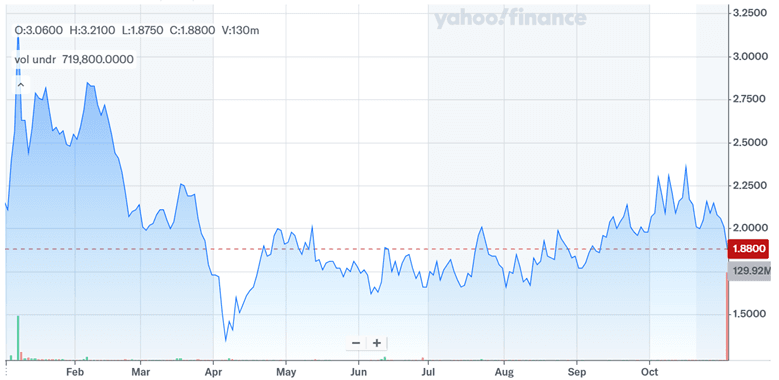Getty Images Strikes AI Deal With Perplexity—Is This The Start Of A Visual Search Revolution?

Getty Images (NYSE:GETY) has taken a major strategic leap by partnering with Perplexity, a San Francisco-based AI search engine startup, in a multi-year licensing agreement that could reshape how visual content is discovered online. Announced on October 31, 2025, the deal gives Perplexity access to Getty’s extensive image library, enabling the AI platform to enrich its search and discovery experiences with high-quality, licensed visuals. In return, Getty enhances content attribution and expands its monetization footprint in the rapidly growing generative AI segment. The partnership comes as Getty continues to build momentum in corporate and editorial segments despite ongoing softness in its agency business. Importantly, this agreement not only provides a new distribution channel for Getty’s content but also affirms its differentiated strategy in AI—leveraging only licensed creative assets. With the Shutterstock merger still under regulatory review and the AI copyright landscape evolving, the deal with Perplexity could have significant implications for Getty’s positioning in the content licensing ecosystem.
Strong Strategic Alignment Between Getty & Perplexity Drives Immediate Use-Case Integration
The collaboration between Getty Images and Perplexity is grounded in an aligned vision for ethical AI and data attribution, positioning both companies at the intersection of technology and creative rights. Perplexity’s platform offers AI-powered search tools that go beyond simple keyword queries, aiming to summarize and contextualize information from across the web. With the integration of Getty’s licensed imagery, Perplexity users can now access curated visual content that is both relevant and rights-cleared—enhancing user trust and enabling more dynamic storytelling. This approach differentiates both companies from competitors who have faced legal scrutiny over the use of unlicensed or scraped content. For Getty, the deal extends its brand presence to a cutting-edge AI environment and increases usage of its premium assets by embedding them directly into a next-gen user interface. From a product standpoint, the integration already shows signs of strong fit: Getty’s images enhance Perplexity’s discovery capabilities while Perplexity boosts exposure for Getty’s archive. As Perplexity scales, Getty’s content will become an integral part of how users visually navigate complex queries—an evolution that reinforces Getty’s relevance in a world shifting toward multimodal search. The deal also helps Getty build a foothold in a segment where traditional search engines are being disrupted by conversational and generative interfaces. By planting its flag early with a forward-looking partner like Perplexity, Getty adds a valuable distribution vector that not only drives licensing revenue but also strengthens attribution infrastructure—a priority for both image creators and platform developers.
Accelerating Adoption Of Clean AI Through Licensed Visual Pipelines
Getty’s AI strategy centers on ethical content usage, and this partnership further advances its market leadership in clean AI pipelines. Getty remains one of the few image providers committed to training AI models solely on licensed content—a position that contrasts with open-source or indiscriminate scraping methods employed by others. As AI adoption intensifies across corporate, media, and e-commerce verticals, Getty’s disciplined approach is increasingly viewed as both compliant and commercially scalable. The company recently upgraded its AI suite to enhance prompt adherence and image output quality, with 70% of usage focused on pre-shot modifications—demonstrating practical utility for design teams. By bundling these AI tools into its iStock subscription plans, Getty has successfully integrated generative capabilities with its pre-existing creative ecosystem. The Perplexity partnership now extends this clean AI infrastructure into the AI-native search market, helping ensure that visual content presented alongside AI-generated answers meets legal, quality, and attribution standards. This integration could serve as a model for how image libraries interface with AI applications moving forward. Additionally, the licensing terms appear structured to deliver front-loaded revenue recognition, as reflected in the Q2 2025 earnings call where “other revenue”—largely driven by such deals—rose to $15.7 million, its highest level to date. With generative AI platforms increasingly scrutinized for IP violations, Getty’s clean-data model positions it as a preferred partner. The scalability of this model depends not just on volume, but on Getty’s ability to replicate the Perplexity framework across additional AI collaborators, thus unlocking recurring licensing revenue at favorable margins.
Editorial & Corporate Segment Strength Offer Operational Stability
Beyond the AI narrative, Getty continues to demonstrate resilient performance in its core business segments. In Q2 2025, corporate revenue rose by high single digits, underpinned by demand from technology, business services, sports, and fashion sectors. Notably, corporate clients accounted for approximately 58% of total revenue, with growth fueled in part by creative content deals that include AI rights. Editorial revenue also posted a 5.6% year-over-year increase, supported by strong global demand for sports and news coverage. Exclusive photojournalism from events like the Formula 1 season, UEFA Champions League, and global political milestones such as the election of Pope Leo XIV contributed to revenue momentum. These segments have helped offset weakness in Getty’s agency business, which declined 10% year-over-year and continues to be impacted by broader advertising sector challenges. Meanwhile, subscription revenue grew 3.7% year-on-year, with annual subscriptions now comprising 53.5% of total revenue. Getty’s subscriber base grew 14% year-on-year to 321,000, and premium access retention improved to over 100% for the first time since 2023—suggesting that enterprise clients are stabilizing post-Hollywood strikes. The positive mix shift toward recurring subscription revenue improves predictability and supports margin stability, especially as the company navigates macro headwinds. Although Adjusted EBITDA was down slightly, margin compression was limited to just 110 basis points year-over-year, indicating operational discipline. The Perplexity deal, while strategic, is not a pivot—it builds on an ecosystem where Getty already has solid client retention, pricing power, and diversified geographic presence.
Debt Load & Free Cash Flow Drag Remain Structural Overhangs
Despite operational traction in AI, editorial, and subscriptions, Getty’s capital structure continues to pose a fundamental constraint. As of Q2 2025, the company had $1.39 billion in total debt, including multiple tranches of high-interest loans and senior notes, with weighted average interest rates in the high single to low double digits. Cash interest expense for 2025 is projected at $123.1 million—consuming a significant portion of EBITDA and placing a ceiling on free cash flow generation. This dynamic was reflected in the Q2 2025 results, where free cash flow turned negative $9.6 million, down from a positive $31.1 million in the prior-year period. The decline stemmed primarily from litigation and merger-related cash outflows, coupled with higher tax payments, but it underscores how sensitive Getty’s financial profile remains to non-operational disruptions. Although the company executed a loan-to-bond exchange in May to shift some 2025 interest obligations into 2026, net leverage remains elevated at 4.3x. This figure ticked up slightly due to FX fluctuations in the euro-denominated term loan but still indicates high reliance on debt financing. While Getty’s underlying business performance is improving, especially in licensing and subscriptions, the burden of interest payments and limited deleveraging capacity could limit strategic flexibility. Moreover, as regulatory reviews of the Shutterstock merger remain pending, investors may assign a discount to the equity until clearer capital allocation paths emerge. These structural overhangs are compounded by volatility in free cash flow yields, which dropped to 18.8% in October 2025 from a peak of 33% in June, reflecting ongoing variability in cash conversion efficiency.
Final Thoughts

Source: Yahoo Finance
Getty’s stock price trajectory has remained more or less flat over the past few months. The company’s trailing EV/Revenue multiple stands at 2.24x and EV/EBITDA at 7.72x as of October 2025—near the lower end of content licensing peers. Meanwhile, its LTM Price/Sales was just 0.82x, suggesting limited market optimism about topline acceleration. While the Perplexity partnership adds a new layer of strategic optionality, valuation rerating may depend on Getty’s ability to reduce debt, stabilize cash flows, and expand AI-related licensing across a broader ecosystem. Until then, investors will likely continue to weigh innovation upside against structural liabilities.




